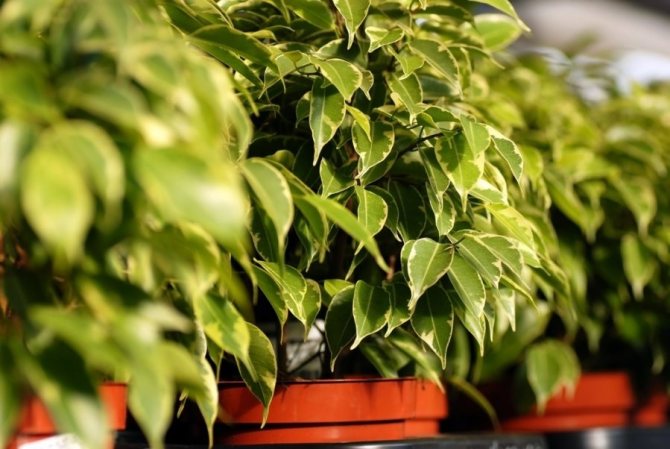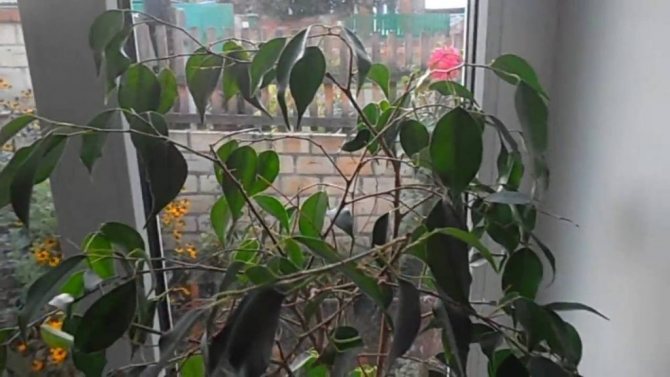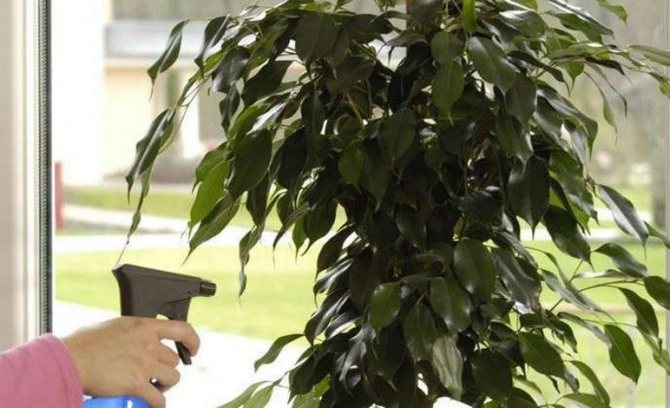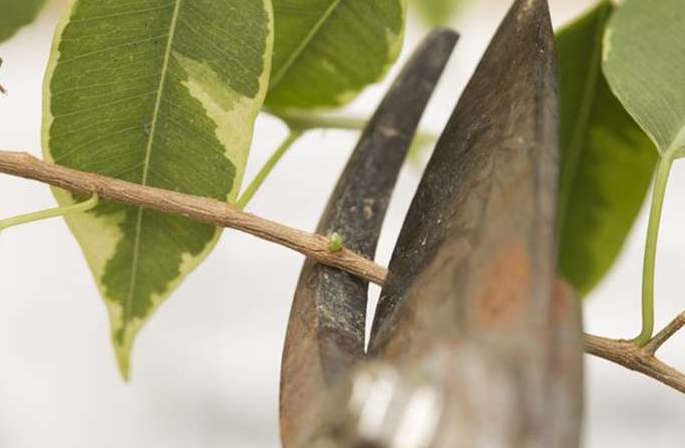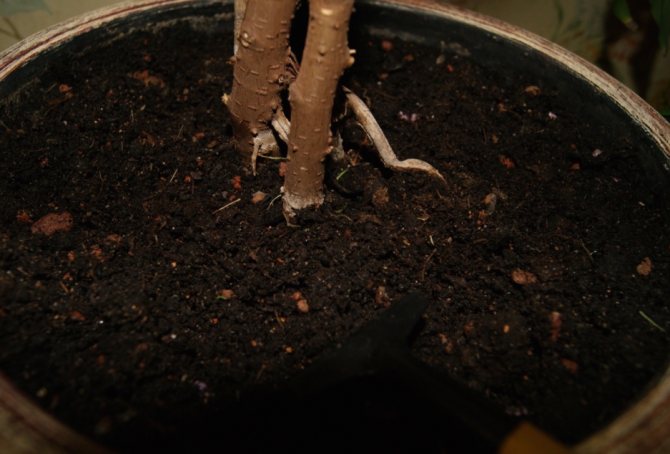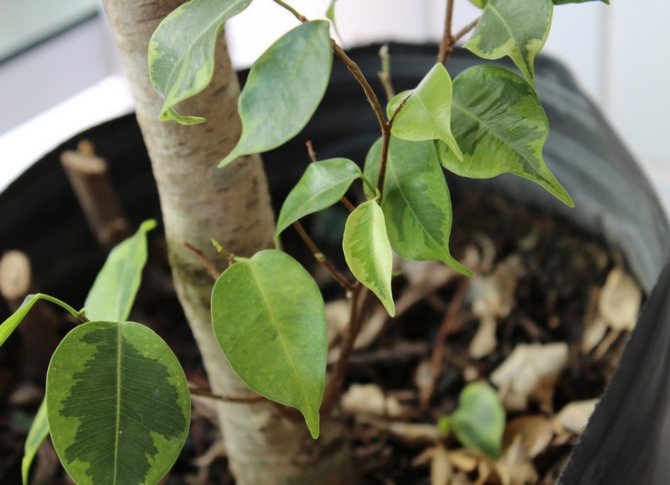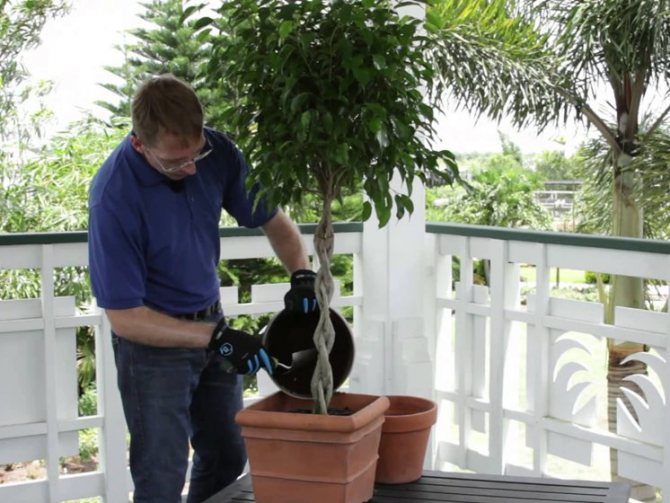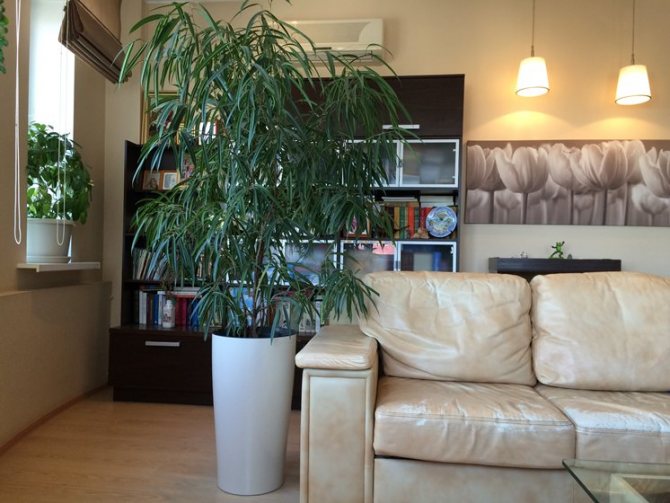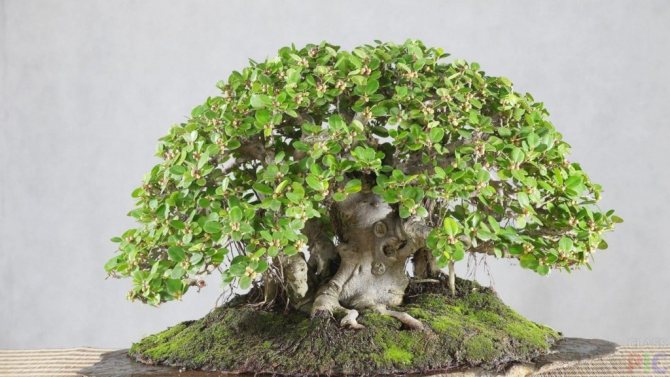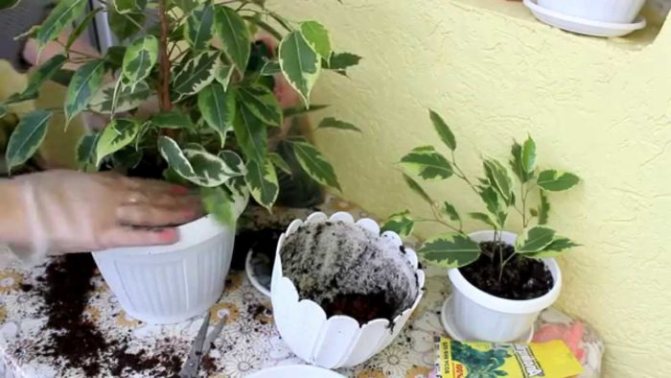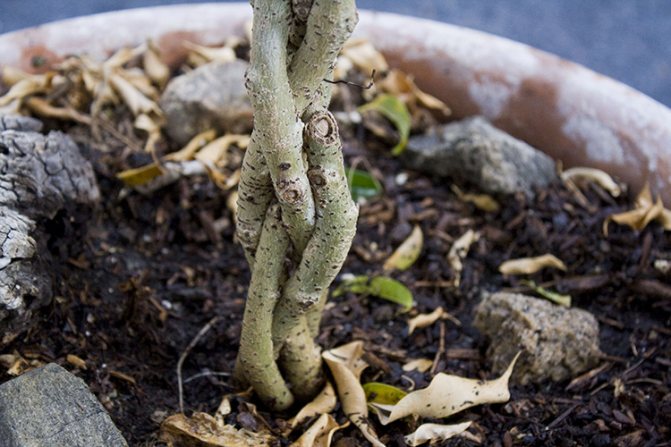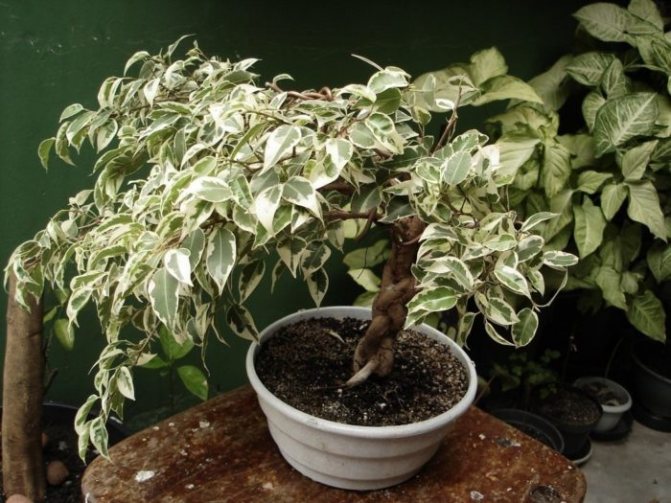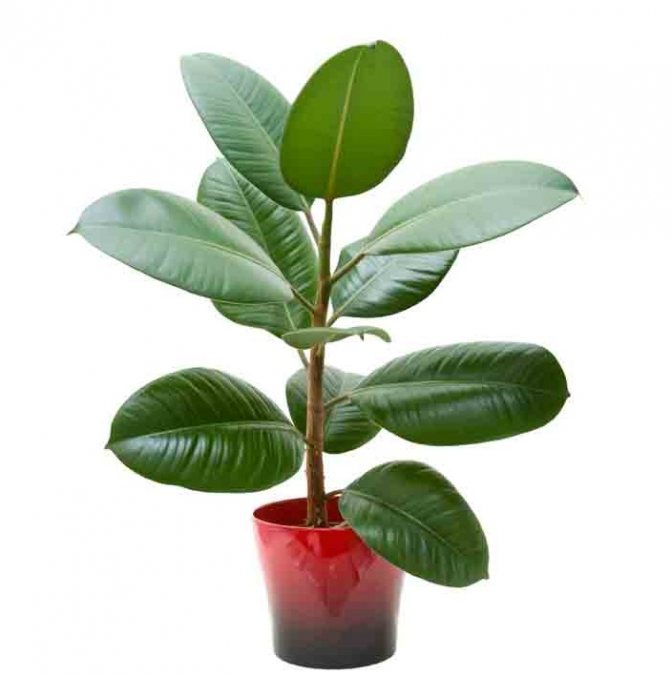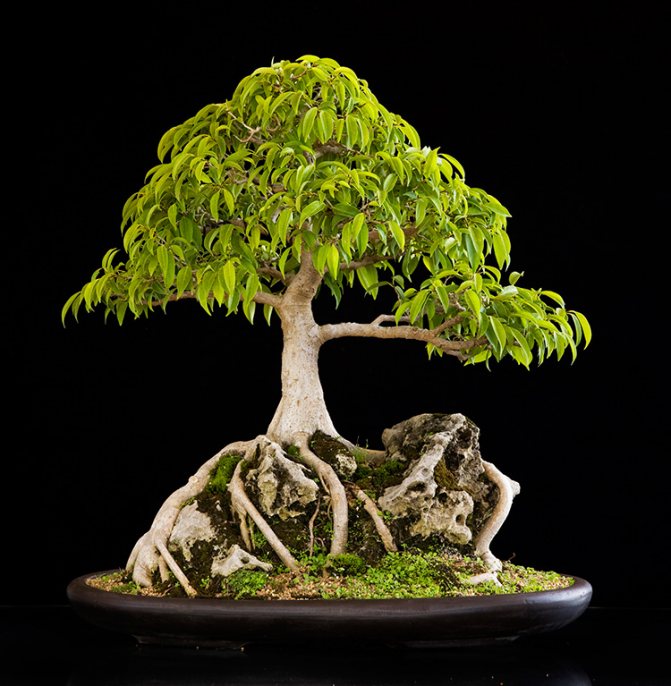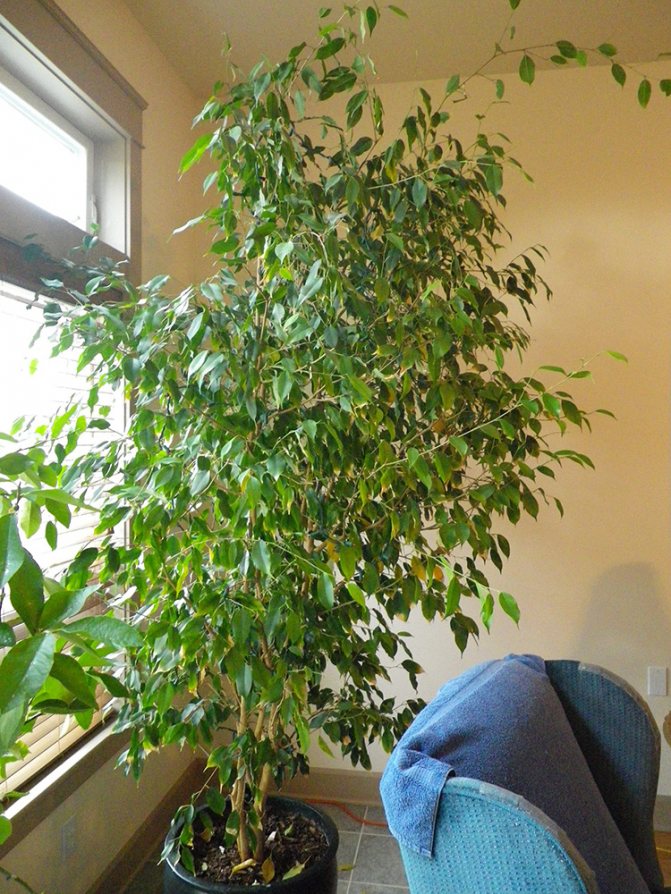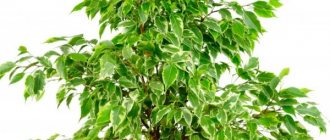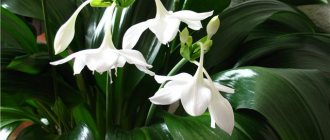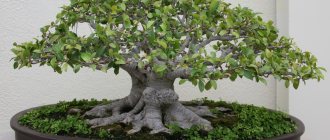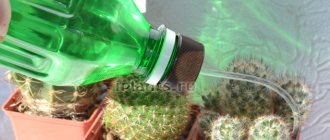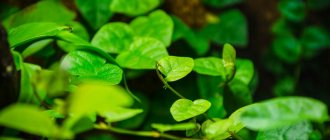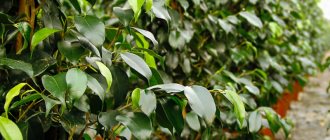Probably, no one will argue with the fact that ficus is one of the most popular plants that gardeners grow at home. This flower is represented by both low-growing representatives (bonsai) and whole bushes, reaching a height of 2-3 meters. A large number of varieties of ficus will allow everyone to choose what they like best.
An important point to pay attention to when growing a plant is the choice of the size of the pot for the ficus. Many do not pay due attention to such a moment, but it is completely in vain, since a lot depends on it.
Lighting and location
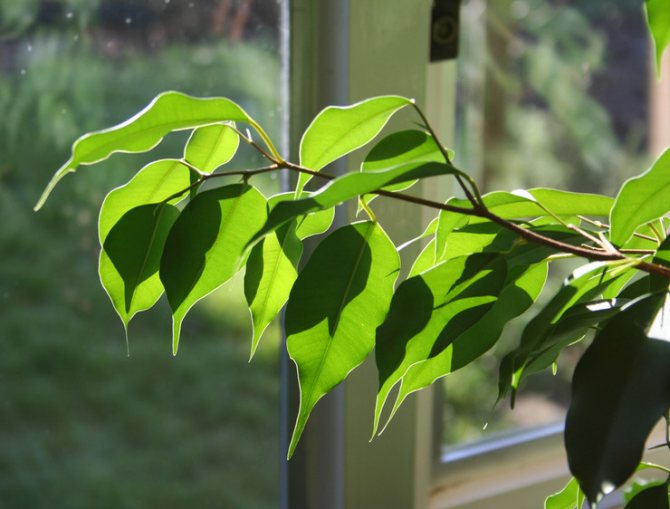
Ficus Benjamin is a light-loving plant. However, we note that varieties with solid dark leaves are best placed in partial shade, with light ones in diffused light. But variegated varieties, in which the leaves contain few green cells containing chlorophyll, will not be able to fully synthesize sugar without bright sunlight. Their illumination should be above average.
The best place to live for a flower will be a wide window sill on the southeast-facing window, or a place on the bedside table near the south window. The northern side is suitable only for varieties of ficus with solid green leaves, and even then in the summer. Additional lighting will be required at other times of the year. There is a lot of bright sunlight on the southern windows, but at noon the hot sun will burn the leaves of the flower.
Let us draw your attention to the fact that a permanent place is one of the main conditions for the normal growth and development of a flower. This is due to the fact that the plant quickly gets used to a certain lifestyle, to the daily routine, and adjusts the metabolic rate. Relocation to another place, even with better conditions, sometimes takes place with great difficulties. Many varieties of Benjamin ficus even shed their foliage, and some may die. So even turning it with the other side to the window is not worth it once again.
Direct sunlight is necessary for ficus in the morning, before 11 o'clock, and in the evening, after 17. But only adult specimens can withstand the midday sun, and even then not all of their species. It is better if a light curtain hangs on the window at this time. Young plants should be accustomed to the sun's rays gradually. In autumn and winter, all types of ficuses should be placed closer to the sun. On short light days, any ficus needs additional lighting, otherwise its leaves will begin to crumble, and in variegated varieties they will also lose their bright color.
Green species tolerate partial shade more easily, but they also cannot stay without sunlight for a long time - their growth will slow down, the crown will become one-sided with elongated faded twigs. If the pot is located far from the window, somewhere in the corner of the room, it simply needs an additional artificial source of illumination, for example, a fluorescent lamp, which should be attached somewhere on top at a distance of no closer than 70 cm from the crown.
It is still advisable to move Benjamin's ficus twice a year: in the summer to the open air, and with the onset of cold weather - back to the house.
Try to find such a place on a balcony, loggia or terrace so that the conditions of its illumination and air temperature do not change much. An ideal place of residence for the summer would be the outer wall of the window, near which the pot stood in the apartment in the spring.We do not recommend placing a flower on the south side - it is too hot there.
We add that the ficus does not tolerate drafts well. This is stress for him, from which he can shed the leaves. Consider this when you ventilate the room, especially during the cold season. Also, the proximity of batteries, fans and air conditioners negatively affects the ficus.
Comments (4)
Natalia
09/14/2017 at 17:15 |
I recently bought a ficus about a meter high, very beautiful, I will take into account all the recommendations for caring for a handsome man. They decided to put it in the corridor, since it is not recommended in the bedroom and living room.Reply
Julia Expert Plodogorod
26.10.2019 at 20:04 |
Hello, Natalia! To understand how to properly care for the described flower, you need to take into account the requirements of a particular variety. What kind of ficus did you buy? In terms of location, this culture loves good lighting, especially species and varieties with variegated leaves. Such plants can be placed even in direct sunlight, protecting only on particularly hot summer days.
For this reason, if the room in which the ficus will be located is poorly lit or the flower is located far from the window, this will affect its health and decorativeness. Shoots will stretch out, lose compactness. Also, foliage may turn pale and fall off.
In winter, these colors may require additional lighting. It is important to monitor the condition of the pet, if there are signs of a lack of lighting, it is better to purchase a phytolamp. Since there are many home flowers that suffer from short daylight hours, you can group them in one place in order to provide additional lighting.
There is one important nuance, so that the crown is evenly developed, it is worth changing the position of the flower relative to the sun once in a while. In addition to good lighting, ficus will positively react to spraying or bathing in the shower. It is better to maintain humidity in the room where the flower stands. You can place a container with water next to the crop.
If bathing will not be carried out, we recommend that you ensure that dust does not accumulate on the leaves. This not only spoils the decorative appearance of the plant, but also interferes with the normal breathing process. To avoid this, large-leaved species can be wiped with a damp cloth. For any kind of hydration of ficus, it is better to take non-cold water.
The flower is not very picky about the temperature regime. In summer it should not be higher than 30 degrees, and in winter it should not be below 12. Watering should be plentiful in the warm season, in the cold - in moderation. If the room is cold, it is important not to overmoisten the flower, otherwise it will get sick.
Top dressing is needed in the spring-summer period twice a month. Although nitrogen should prevail in the composition of fertilizers, it is important that the plant receives potassium as well. This will improve immunity.
Of the diseases, scabies and spider mites are dangerous. In the first case, mechanical removal will be required with a brush or cotton swab dipped in alcohol or soapy water. If you follow the conditions of optimal humidity, spray and bathe the flower, the likelihood of developing ticks is small. For treatment, you can use Neoron or a solution of soap and ash.
As for the location of this flower in the bedroom and living room, there are no contraindications. This plant is absolutely non-toxic, it cleans the air. The only caveat is that it is better not to place any large plants in a small bedroom, because they also breathe at night, so the room can be stuffy by morning.
It is believed that this flower is the guardian of the family hearth, according to feng shui it symbolizes wisdom, according to other teachings, it establishes energy flows in the house and protects people living nearby from anxiety.
Reply
Valeria
01.11.2018 at 00:19 |
It is better to immediately transplant a decently grown ficus into a large pot, otherwise the plant will grow up, and its pot will become absolutely unstable and will not stand on the ground normally and the flower will break if it falls.
Reply
Julia Expert Plodogorod
26.10.2019 at 20:29 |
Hello Valeria! When transplanting ficus, we recommend adhering to the rule - the pot should be 2-3 cm larger than the rhizome on all sides. If you choose a large container, the risk of rotting of the root system and its defeat by a fungus increases.
When watering, the roots will not be able to reach and absorb all the poured moisture, which will lead to its stagnation. The consequence of this will be rotting, softening and dying off of some of the root processes. In case of such problems, you will have to transplant again, which will be accompanied by the rehabilitation of the root system.
As a result, the plant will be weakened and will lose some of its decorative effect. With severe damage, recovery can be very long. Do not try to reduce the number of transplants in this way.
We would like to note that some varieties of ficuses, especially at a young age, are transplanted quite often, once a year. This means that it will be possible to timely change the container to a large one, which will prevent injury to the flower from falling due to a too high and heavy crown.
This plant really has a massive and high crown, especially when the ficus is already mature and developed. Therefore, it is important to choose a container based on the type and condition of a particular instance. If there is a concern that the pot is not stable enough, we recommend choosing heavy ceramic flowerpots. You can also place any pot in a stable and heavy planter.
Of course, pots are usually made for decoration, because they are light, for example, if you choose some kind of wicker option. But, now there are a large number of decorative ceramic options on sale. Therefore, you can easily choose a stable container for ficus, while not planting it in an unsuitable pot.
Reply
Temperature
Ficus Benjamin is a thermophilic plant. But, he has a lot of varieties. You can read more about popular types in another article... For example, variegated varieties grow better at 24 grams. Some species prefer low temperatures, from 18 to 20 grams. heat, others - not less than 30 gr. and are able to withstand higher temperatures, but subject to high humidity and good watering. If your flower is in the open air, with the threat of a drop in temperature at night below 16 degrees, return the ficus to the room, otherwise it will freeze.
It may be interesting: Croton (codiaum) - home care
The flower needs special care in autumn and winter. The temperature in the winter in the room should be in the range of 17–20 degrees, not lower. If the heating is not turned on for a long time in the fall, and the room is cool, take care of the flowers on the floor or windowsill. Turn on the heaters. If they are not there, wrap the pots, move them to places where they are not threatened by cold air currents.
For bonsai
Bonsai is the ancient Chinese art of growing small copies of large trees. Ficus "Benjamina" is great for making bonsai at home. To do this, you need to choose the right pot, taking into account the aesthetics of the appearance of the plant and the characteristics of its growth. The bonsai pot should be flat and more like a tray. The height of such a bonsai tray is usually 10 cm and is optimal for the formation of the root system necessary for the plant. In the process of growth of the ficus in this technique, its trunk thickens, and aerial roots grow.
The width of the container often depends on the size of the plant's crown: the larger and wider it is, the larger the width of the bonsai tray should be. In the case of growing ficus bonsai, it should be noted that the surface of the root system is very small in relation to the aboveground part, and a container made of breathable materials such as wood or unglazed clay is best suited in this case. Most often, bonsai are grown in clay trays. Aesthetically, it looks very harmonious.
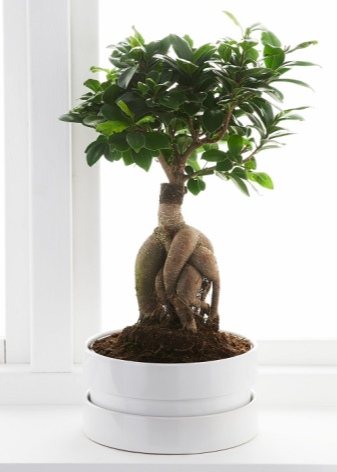

Humidity
Ficuses love high humidity as much as bright light. You will have to take care of this if the air in the room is dry. Spray the flower daily during the warmer months, and less often in the winter. Add aspirin to the spray water occasionally (1 tab. To 1 tbsp. Water). Wipe dust off its leaves. Give him a refreshing shower in the summer. It is useful as a prophylaxis against all kinds of parasites. Do it like this.
- Place the pot of ficus in the bath.
- Cover the soil with a plastic bag so that it does not wash out.
- Water the crown of the plant for several minutes with lukewarm water from the shower. This procedure will remind the ficus of its native habitat, create the illusion of a tropical rainstorm.
ANDrarely, you can dip the plant with its crown in a basin of water. Of course, if its dimensions allow.
In any case, after bathing, hold the ficus for half an hour in the bathroom, let it dry well. After that, you can return the flower to its place in the sun.
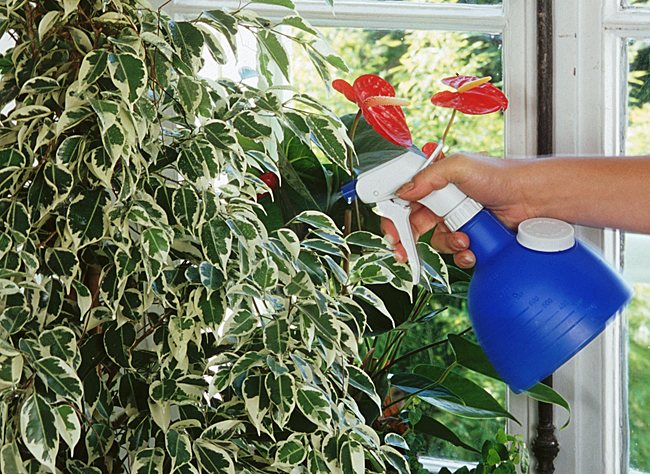

In winter, during the heating season, the humidity in the premises should be increased more intensively. If you have a household humidifier, turn it on. If not, spray the plant with a spray bottle. Use soft, settled, slightly warm water.
Material
The assortment list of pots offered by manufacturers for planting home flowers and plants is quite wide, as is the choice of materials from which they are made. Among them are containers made of ceramics, plastic, wood and even metal. Ficus is a rather picky flower in terms of the material of the container in which it grows. It feels great and develops well in both clay and plastic containers.
If there is a choice, then preference should be given to clay containers., not covered with a glossy glaze, since the clay has a porous structure, is breathable and improves root respiration. It should be borne in mind that over time, the clay pot can become covered with a white coating from the salts contained in the water, or turn green, since it absorbs moisture well. Also, the appearance of clay containers for flowers may seem unaesthetic.
A clay pot covered with glaze has a more attractive appearance than a product with a porous ceramic surface. However, such a container does not conduct light well and has a greater weight, which can make it difficult to care for the plant. If you decide to use glazed ceramics, take care of a sunny spot for the plant. At the same time, nothing terrible will happen if the ficus is planted in a plastic pot. At cost, it can be anything, the main condition is that the plastic does not emit substances harmful to the environment and plants. In addition, plastic products are brighter, with a beautiful design. The weight of the flower together with the earth in plastic is much less than in ceramics.


Glass plant pots are rare. If you come across a beautiful glass specimen, and you decide to plant your flower there, remember that this is a rather fragile vessel that requires careful handling. At the same time, it is worth paying tribute to the spectacular appearance of the glass container, which can be colored, transparent or matte. Wooden pots for ficuses are usually chosen in the form of a tub, in which the ficus fits very harmoniously into various natural and eco-styles. The tree is perfectly saturated with water, so often wooden tubs are used as pots, in which clay pots with ficuses are installed. Along with clay, wood is a natural material that excludes environmental pollution.
It should be noted that during the selection and purchase of a pot for ficus, the presence of a drainage system is of great importance to drain excess liquid, which is detrimental to the root system of the plant. These pots are often designed with a spout to drain the water. In the absence of drainage in the pot, the risk of losing the plant is maximum, especially if it is made of materials that do not transmit or absorb moisture, such as: glazed clay, plastic and glass.


How to water
Ficus Benjamin does not tolerate drying out of the soil. In the summer he drinks much more, the soil dries up quickly - he will have to water every 3-4 days. If the soil is already dry 2–3 cm deep, water it. If the soil in the pot has not dried out, for example, due to cloudy days or a drop in ambient temperature, then you should not water the ficus - let the top layer dry out.
In winter, it is enough to water Benjamin's ficus once a week or a little less often. But, you should not forget about watering your pet for a long time. He will shed his foliage.
Use water for irrigation soft, settled or boiled, not higher than room temperature. Waterlogging of the root system is not permissible. Excess moisture can provoke leaf fall. Therefore, it will be better if your pallet is not deep. And you will remove excess water from the pan on time.
Conditions for the plant
When creating conditions for ficus, you need to remember that the plant loves warmth. Therefore, you need to monitor the temperature in the room. Especially in the winter.
Ventilate the room in time without creating strong drafts. The location of the flower should not be exposed to direct sunlight, but be well lit.
There should not be too dry and waterlogged soil in the pot. The container itself should be comfortable and fit in parameters to the size of the plant.
All this will help keep the flower healthy and respectable.
Expert opinion
Yulia Yurievna
I have a large garden and vegetable garden, several greenhouses. I love modern methods of plant cultivation and soil mulching, I share my experience.
Ask a Question
How to feed
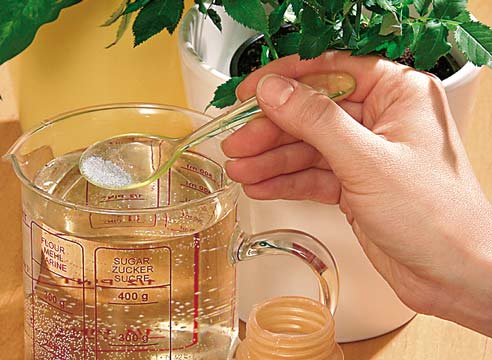

Ficus Benjamin needs feeding from spring to autumn. The frequency of feeding at different times is different. In March – April, it is enough to feed the plant once a month. In June, the ficus grows actively. And you will have to feed him more often - once every 2 weeks. And so on until September. In the autumn months, again reduce the feeding to once a month, and in the winter you do not need to feed - let it rest. The nutritious soil guarantees the successful growth of the plant, the beauty of its trunk and the bright color of the leaves.
Organic and mineral compounds, vegetable compost mixtures are used as fertilizers. You can buy a special fertilizer for ficuses or a complex fertilizer for decorative foliage plants in the store. Fertilize according to the instructions attached to them, do not overdo it with doses, even better pour more water than indicated there. Choose a fertilizer with a high nitrogen content, as it has a good effect on the growth of the green mass of the plant. You can also feed Benjamin's ficus with a spray bottle (foliar dressing). To stimulate the growth of new branches, the drug "Epin" is bred, and "Ferrovit" is used when the plant does not have enough iron, and its young leaves acquire a yellowish tint.
We can also recommend to you folk recipes, time-tested: dilute 1 tbsp. l. sugar in 1 liter of warm boiled water. Pour your ficus abundantly with this solution (and a couple - three other flowers, if there is an excess solution). Enough two sweet dressings for the summer. Glucose is an excellent source of energy for the life processes of all plants. Ficus is no exception.
If your goal is to quickly form a dense and beautiful crown of the plant, then feed your pet more often. Top dressing is able to increase the volume of leaf mass of ficus by three or even five times per season.
Form for traditional ficuses
A pot for ficus should be chosen the most ordinary one, without any special structural refinements. It would be ideal to plant it in a container of the correct shape, which is created by the approximate equality of the parameters of height and width. This rule applies to almost all types of ficus, such as the “Benjamina” ficus and the rubbery ficus. At the same time, round pots should be avoided, since the roots of the ficus can be damaged during transplantation. When they are injured, the plants get very sick.
A pot that is too elongated is not suitable for ficus, since the volume of land in it will be much larger than required. If you love this shape, and it is necessary to create a stylish interior, then an elongated planter with a fake bottom at a higher level can be a way out.
When and how to transplant into another pot
It is best to do a Benjamin ficus transplant at home in March or April. Young specimens need a transplant every year, and adults - once every three to four years. In between, remove the top layer of the substrate from the pot and replace it with fresh.
This may be interesting: Peperomia - the secrets of growing at home
Transplant your ficus as follows. Remove the flower from the old pot with a lump of earth and transfer it to the center of the new pot, where a layer of drainage and a layer of new substrate have already been laid. Cover the voids between the plant and the sides of the pot with earth, shaking the pot lightly. If the room is hot, lightly water the transplanted ficus and spray its crown with a fine spray bottle. If the room is cool, then it is better not to water the transplanted plant for a couple of days.
Young ficus benjamin bushes should be checked frequently for rapid root growth. To do this, turn the pot over and look at its bottom. The roots may already be peeking out of the drainage holes. If so, rejoice, you've got a fast growing specimen. Without waiting for next spring, you will have to transplant it into a new, slightly larger pot.
What kind of pot is needed
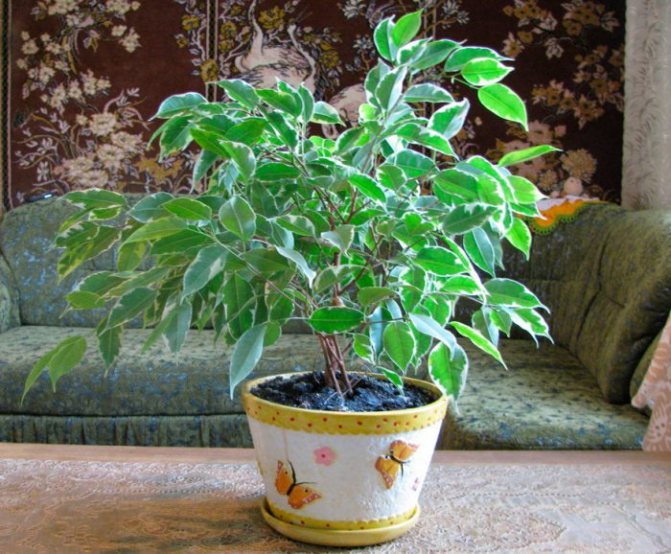

Choose a clay or ceramic pot for Benjamin's ficus. The new pot should not be too bulky, only slightly larger than the old one. Then the root system of the flower will quickly cope with the development of the entire volume of the new soil, and the flower will more easily take root in a new place. Let's immediately pay attention to the size of the pot for creating a bonsai from ficus - it should be wide and shallow.
Suitable soil
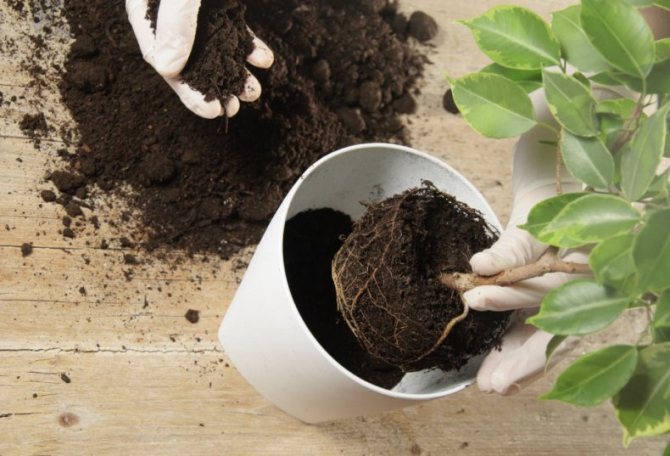

The natural habitat of Benjamin's ficus is the humid tropics with their characteristic moisture-absorbing nutrient soil. For indoor cultivation, you need to buy or prepare the substrate yourself, similar to its natural composition. For Benjamin's ficus, purchased land for ornamental deciduous plants is suitable. You can use the soil for Mulberry plants or for Palm trees. Note that ficuses are not very picky about the composition of the soil. It is only important that it is nutritious, breathable and has neutral acidity. Self-prepared soil should be as follows: a mixture of peat, garden soil and sand in equal proportions. You can add a little wood ash to eliminate acidity in the soil. Adult specimens require a denser substrate, so turf and humus should be added to this soil composition.
Do not forget! At the bottom of the pot there should be a good layer of expanded clay or other drainage material with the addition of pieces of charcoal.
How to transplant ficus correctly if it is sick?
Sometimes, due to mistakes in care, the plant begins to hurt.The ficus root system can rot and become infected with a fungus if there is no good drainage in the pot, the soil is too dense, or there were regular overflows. Also, diseases are promoted by low temperature or its drops, the presence of drafts, the wrong mode of fertilization. If the roots begin to rot, the aerial part looks sluggish. Leaves may turn yellow and fall off. The soil will acquire a characteristic unpleasant odor. In the described case, a plant transplant will be required. How to plant ficus at home? You need to start by carefully removing the plant from the soil. Next, we recommend rinsing the root system under lukewarm water. Then you need to examine the root system and remove the damaged parts. The flower that has undergone sanitation is transplanted into clean soil and a new pot. In the next two waterings, it is better to moisten the plant with a fungicide solution. Manganese or boric acid can be used.
While watching the video, you will learn about the cultivation of ficus.
Ficus is rightfully one of the most beautiful and spectacular types of domestic flora.
Correctly chosen pot and care, timely transplantation, competently performed reproduction are the key to a successful and long life of your pet.
Attention super FLY!
Houseplants
Interesting to read:
- How to transplant Benjamin's ficus: detailed recommendations for all stages
- How rubber ficus reproduces at home: main characteristics
- How to make a beautiful bonsai from ficus
- Ficus: flowering, care features
- Reproduction of ficuses: how to take a shoot, root it in a substrate and water
- How to prune ficus correctly: types of ficus, pruning forms, subsequent care
- Reproduction of rubber ficus: its diseases and pests
- Ficus lyre - growing, reproduction and care
- Ficus leaves turn black: causes and methods of eliminating the problem
Dormant period
Evergreen tropical plants do not have a pronounced dormant period, therefore, they need to provide approximately the same lighting, nutrition, warmth and humidity throughout the year. If you have difficulties with this, then you can arrange temporary rest for your pet, for a couple of winter months, by moving it to a room with an air temperature of 16-18 grams. Cutting, feeding and bathing the ficus at this time is not worth it.
We wrote a separate article on shaping the appearance of Benjamin's ficus, because there is a lot of information there. In it you can learn about the intricacies of weaving the trunk, about the correct pruning of the crown, as well as how to grow bonsai from this amazing plant. We recommend that you read this article at the link: Shaping the appearance of Ficus Benjamin.
The size
After purchasing a ficus, it is necessary to evaluate its native pot and the availability of a stock of free space in it. If the roots of the plant are already getting cramped, then within a month it must be transplanted and do not wait for the roots to sprout out through the drainage hole. In addition, the ficus itself increases in size, there is a possibility of the pot overturning, since the upper part of this plant can grow quite powerful. When choosing a pot for ficus, you must follow the 2 centimeters rule, that is, there should be 2 cm of free space for root growth. Otherwise, there is a risk of inhibition of plant growth, since the ficus will throw all its strength into building the root system, and only after filling the pot with roots, it will begin to grow above the ground. Also, too large a pot increases the likelihood of root rot, since in this case the likelihood of overflow increases.
Ficuses should be transplanted at the moment when the root system has completely filled the pot and met its walls. In the case of ficuses, the following rule or pattern can be derived: each subsequent pot should be 2 cm larger than the previous one.It should be borne in mind that some types of these plants grow incredibly quickly. For example, rubber-bearing ficus requires transplanting once a year, other species are transplanted once every 1 to 3 years. And also observations show that the older the plant, the less often it needs to be transplanted. If you think that the ficus has grown to the required size of the crown and root system, then you can carefully take it out of the pot, trim the roots and crown and return it back to the same pot, leaving the same 2 cm for the growth and development of the root system.
Reproduction
Theoretically, the plant can be propagated in different ways: both vegetatively and with the help of seeds. In practice, all types and varieties of Benjamin's ficus are propagated by cuttings, which remain in abundance after the spring pruning of the plant. Although, cuttings can be cut and rooted all year round, in spring the vegetation rate of the shoots is maximum, and they root better.
Do it like this. Using a clean tool (knife or secateurs), cut off the apical shoot from the ficus with a length of at least 10 - 12 cm. Do not touch the upper leaves, you need to remove only a couple of the lower ones, at the cut. The stalk on the cut will emit droplets of milky juice - they should be blotted with a sterile napkin or rinsed under running water until it ceases to stand out. If the juice is allowed to harden, it will prevent root formation. Then air dry the cut. Now you can put the cutting to root in water or directly into the substrate. Let's consider both options.
Rooting in water
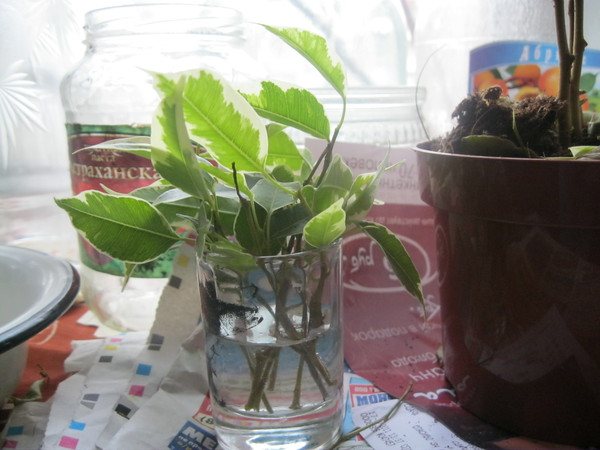

Note that in spring, cuttings of ficuses form roots more readily than at other times of the year, even in plain water. The procedure is as follows:
- Place the prepared stalk in a glass (preferably opaque) with water. The water should be settled, at room temperature, no more than half a glass, so that the lower leaves of the water do not touch.
- It is advisable to add half a tablet of aspirin and activated charcoal to the water in order to surely exclude rotting of the shoot. If desired, you can add a few drops of some drug that stimulates root formation, for example, Kornevin, to the water.
- Place the container with the handle in a warm place (about 25 grams), illuminated by the diffused rays of the sun. The water will evaporate - do not forget to top it up to the previous level. The roots should appear in two to four weeks.
- When the roots have grown a little, transplant the cutting into a pot with suitable soil, cover it with a bag or jar to create a greenhouse effect with high humidity.
- From time to time, open the greenhouse for ventilation, and to accustom the young plant to the temperature of the apartment.
- The guarantee of successful rooting will be the appearance of a new sprout in a week - another next to the transplanted cuttings. Then the shelter can be removed, and the pot can be rearranged to the place chosen for it.
It might be interesting: Fittonia: home care
Rooting in the substrate
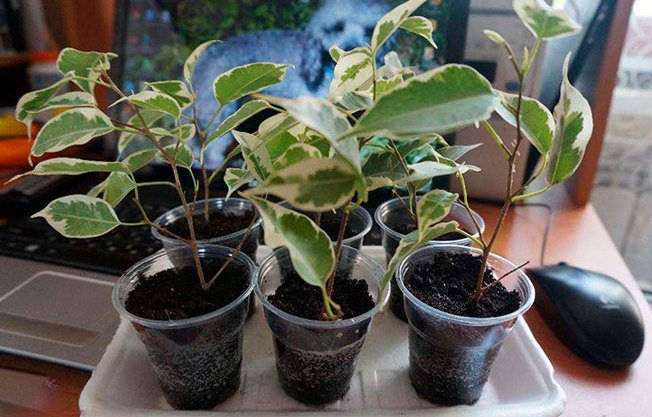

It is believed that the bush obtained in this way grows and develops faster. It is important here that the composition of the substrate is most suitable for Benjamin's ficus: fertile, breathable, with neutral acidity.
- Place the cutting in a small pot with drainage and substrate, centered.
- Pour with settled water with the addition of Kornevin or other similar preparations, for example, Gilea.
- Cover the glass with plastic wrap or another glass on top to create a mini greenhouse.
- Place this greenhouse in a warm place with ambient light for three to five weeks. During this time, the roots should appear at the cutting.
- The shelter can be removed. As soon as the sprout grows, it can be considered that rooting was successful.
We advise you to root several cuttings at once, in case some of them die. Later, you may want to experiment with the surviving "extra" sprouts and create an unusual shape from the sprouts intertwined in a pigtail or otherwise fused.
What color to give preference


Perhaps this is the simplest thing that can be. Today, there are so many colors on the market that it will not be difficult to choose a suitable pot for ficus. Some gardeners advise paying attention to light colors that harmonize very nicely with the green shades of the leaf plates. If you are purchasing a ceramic flowerpot, then you can take a closer look at products that have a fancy and delicate pattern.
By choosing the right flowerpot, the flower will grow quickly enough and develop well.
Diseases
The main cause of Benjamin's ficus diseases is a violation of the conditions for caring for him:
- insufficient or excessive watering;
- non-observance of the temperature regime or the level of lighting;
- lack or excess of fertilizers.
So, the appearance on the leaves of ficus Benjamin yellow spots and bumps occurs due to waterlogging of the soil.
Leaves dry and curl due to the low humidity of the ambient air.
The edges of the leaves began to turn yellow - it means that the flower does not have enough nitrogen, most likely, you have not fed your plant for a long time.
What to do if Ficus Benjamin leaves fall? If your ficus is rapidly dropping its leaves, it can still be reanimated. To prevent leaf fall, you should check the condition of the root system. Trim dry or decayed roots, dust the cuts with powdered charcoal or activated charcoal. Then transplant the plant into a smaller pot, completely replacing the substrate with a new one.
There are also a number of specific diseases, namely:
- Botrytis - appears as a whitish bloom on the leaves;
- Cercosporosis - characterized by the appearance of dark blotches on the back of the leaf plate, which then lead to wilting;
- Anthracnose - expressed in the dryness of the edges of the leaves, the formation of brown spots.
If such problems are found, the damaged parts of the plant should be removed, the flower should be treated with a suitable fungicide, kept in quarantine, maintaining good care and supervision.
Material - what is better to pay attention to
Despite the fact that ficuses are quite unpretentious plants and can "live" in almost any pot, it is still recommended to pay attention to the material from which it is made.
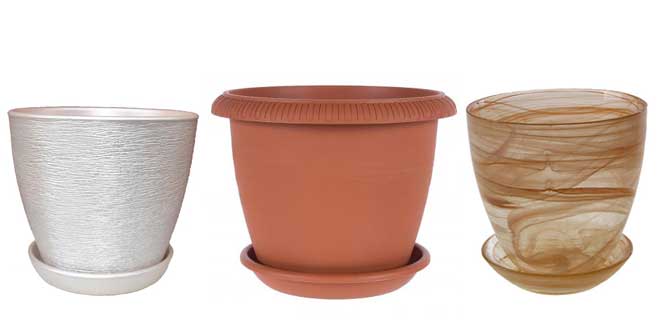

You need to understand that not all containers are safe, we are talking about toxic materials, from which flowerpots can also be made. Some manufacturers, in order to save a little on production, use poor quality plastics, which, when in contact with soil, water or fertilizers, begin to release toxins. It is the latter that adversely affect the plant.
There were cases when the flower began to fade gradually, but the reason could not be found. And only an accidental transplant into a new container saved the situation.
Therefore, when thinking about which pot you need for a ficus, it is best to choose proven materials.
These include:
The latter material is relevant for the manufacture of large tubs that can decorate any room.
As for the clay containers, they are usually used for planting bonsai.
Ceramics is an expensive material, but beautiful, durable and, of course, natural, so if possible, you should pay attention to it.
If the florist is familiar with the manufacturing company and has repeatedly bought the pots of the presented company made of plastic, then you can purchase them as well. At the same time, having noticed some negative changes occurring with the flower, as well as eliminating all possible problems, it will not be superfluous to change the flowerpot by buying a pot made of natural material.
Pests
Among the pests that can cause damage, the most dangerous are scale insects, aphids and spider mites.
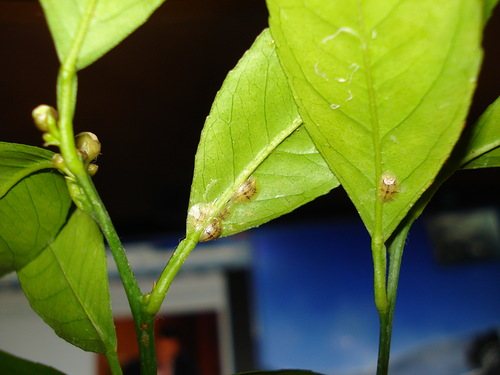

Scabbard on ficus
Scabbards more often than others attack ficus.You will find them by brown or black plaques, in which insects hide under a protective waxy shell.
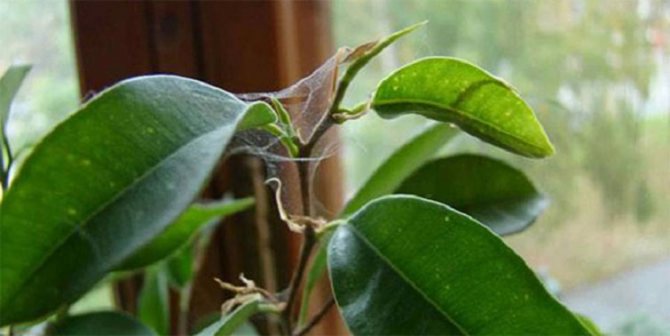

Spider mite
Ticks can also attack ficus. You will not miss even the appearance of a small number of ticks. You will definitely see if small reddish or brown dots crawl along the leaves and branches of the ficus. If a cobweb appeared on a ficus, it means that you missed the initial stage of this attack, and the ficus needs to be treated urgently.
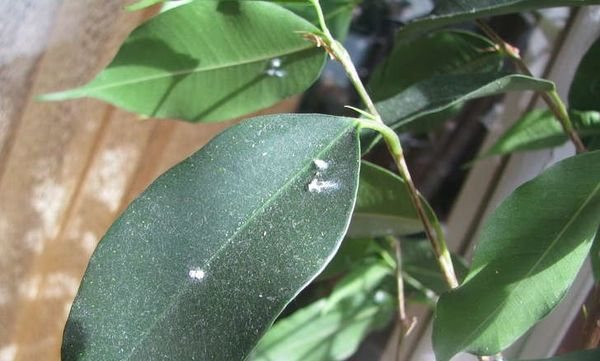

Mealybugs appear as whitish-fluffy lumps on twigs at the base of the leaves and on the roots


You will find aphids in the form of green or dark small insects on the underside of young leaves.
If any parasites are found, take the flower to the bathroom first and rinse the insects off the leaves with a shower with lukewarm water. Cover the soil before this with polyethylene so that it does not wash out. Dry the flower for half an hour in the same place, in the bathroom, and then treat it with a suitable insecticide. To buy the right drug, first take a picture of your pests on your phone so that the seller in the store will tell you the most effective means of dealing with them.
If the problem arose in the summer, and you have the opportunity to take the flower out into the open air, then chemical treatment is best done there.
And further. If several treatments are expected according to the instructions, do not neglect this. Nobody succeeds in removing the population of many insects from one go.
Formation of the crown of rubber ficus
In order to properly form the crown of a ficus, you need to know the biological characteristics of this plant. The apical bud is actively developing in ficus rubber. Only when the ficus rests against the ceiling will lateral shoots begin to develop.
If the top of the ficus is bent to the bottom (window sill, floor) and fixed, then the bud that is the highest on the stem will wake up and become a new dominant shoot, and the growth of the bent shoot will stop. When the lateral shoot begins to actively grow, the top of the ficus can be released. By the way, adult ficuses are less amenable to crown formation. On the lignified trunk, the kidneys almost do not wake up.
The best time for pruning rubber-bearing ficus is early spring, the beginning of the growing season. And if at this time to trim the main shoot of the ficus, this will stimulate the awakening of a large number of axillary lateral buds (or all the buds that should remain after pruning), from which lateral shoots grow, of the same growth strength. With the help of spring pruning, you can get a rather lush crown from a rubber-bearing ficus.
If pruning is done at other times of the year, then it will not have the proper effect on the ficus. As a result of late or winter pruning, when the ficus is in relative dormancy, only the bud that will be the top after pruning will go into growth, the rest may not wake up. The result is a one-sided plant - even worse than it was.
Ampel and creeping varieties


The creeping ficus (Ficus pumila) is a small climber, with long, thin shoots and tiny, almost round leaves.
The leaves can be green or white, depending on the variety. It is the perfect flower for hanging containers. It looks great in compositions with other plants with decorative leaves. Grows well even in darker rooms.


The arrowhead ficus is a creeping plant. It forms roots at leaves embedded in long, thin shoots. Leaves larger than F. pumila, about 5 cm long, sharply overturned. It needs more light than a creeping ficus. Also looks great in compositions with other plants.
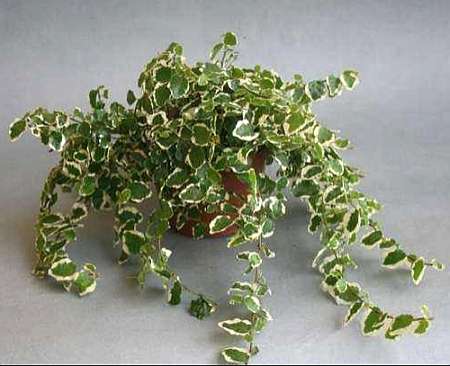

Origin and appearance
The evergreen belongs to the Ficus species, the Moraceae family. Habitat - the countries of East Asia, the north of the Australian mainland.
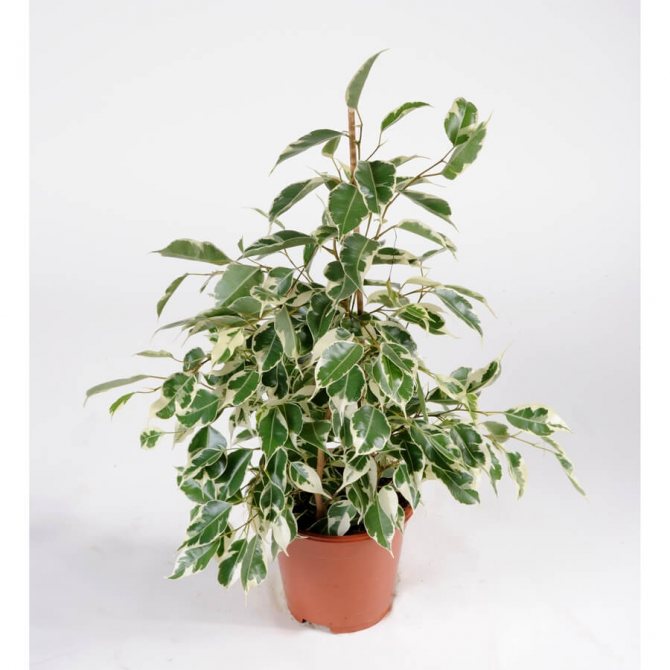

Ficus Benjamin
According to the ancient Chinese science of Feng Shui, a tree personifies wealth, money.It disinfects and cleans the surrounding air well.
The plant has a gray round trunk with single strokes of brown. Due to its flexibility and the possibility of growing together with other shoots, plants with intertwined trunks are created from it. Florists grow bonsai from it.
Young shoots are erect, lignify quickly with age. The crown is thick, wide.
The leaves are leathery, glossy, thin, oval in shape with a pointed end, located on small cuttings. They grow on twigs in the same plane. The edges of the leaf are smooth. The color and size of the sheet are determined by the species.
The flower of Benjamin's ficus is nondescript. Fruits are paired, round or oblong in shape, up to 2 cm in size, are called syconia.
Attention! Ficus Benjamin fruits are inedible.
The growth rate of domestic species is low. If you take good care of a tree, then it grows by about a meter in 10 years.
At home, ficus is a tree or shrub, up to 20-25 m high. An indoor plant grows up to 2-3 m.If you do not carry out molding and pruning, it grows to the height of the room.
Bengal ficus (Ficus benghalensis)


Among the varieties of ficus, whose photos and names are heard by fans of exotic cultures, Bengali ficus occupies a special place. A characteristic feature of the plant is the ability to form a banyan tree. This term refers to the growth of one tree to the size of a real grove due to the rooting of numerous aerial roots.
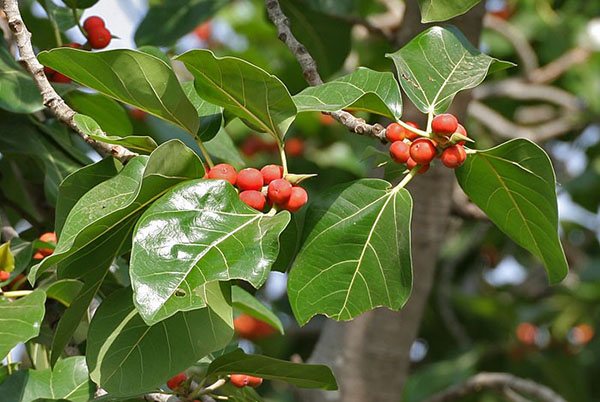

The Bengal ficus has a light brownish bark, smooth oval-ovoid leathery leaves and small reddish-orange fruits.
Feedback on action will take
Reviews say that many signs related to Benjamin's Ficus work.


Many women testify that this plant helped them get pregnant.
Often a child appears with girls who have received a ficus as a gift.
One of the women notes that this flower, although beautiful, is too capricious. If something does not please him, he is able to throw off all the leaves. In such cases, you can prepare for trouble. Conversely, with good care, the tree will always thank its owner.
Most of the reviews about Benjamin's Ficus are positive - this is the main indicator that this plant benefits the house and its owners. Provide the flower with good care, do not forget about timely irrigation, and it will fill your life with positive energy.
Can Benjamin Ficus be kept at home?
Many indoor plant lovers are wondering: is it possible to keep Ficus Benjamin at home? Different peoples have different opinions on this matter.
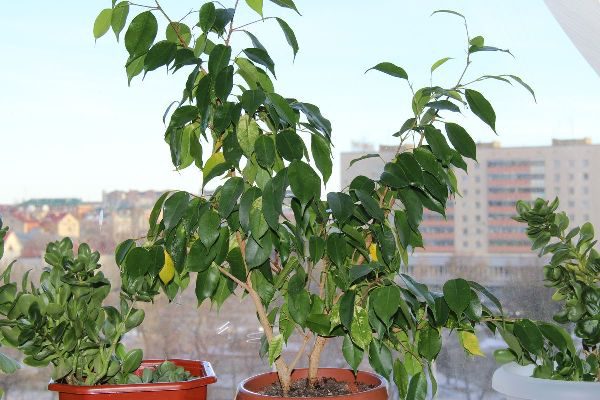

Ficuses are quite common plants for our homes.
Residents of eastern countries assure that the ficus is a symbol of family happiness. The Slavs, for a long time, were in the belief that this is a tree associated with witchcraft, bringing trouble.
In China, it is customary to decorate your home with Ficus Benjamin to gain family well-being. This plant is often presented as a wedding present. There is even a tradition of passing it on from one generation to the next. According to popular beliefs, it cleans the home of negative energy, energizes, makes a person physically more enduring.
It is considered the perfect gift for the elderly.
The inhabitants of Thailand have raised the ficus to the rank of a sacred plant. They believe that he scares away evil. One of the species of this plant is adorned with the coat of arms of Barbados.
Slavic peoples think that ficus leaves are endowed with magical properties. There is a belief that the plant brings discord in the family, provokes conflict situations and can cause divorce. And in the post-war period, when there were no men in many families, they began to ascribe muzhegon qualities to him.
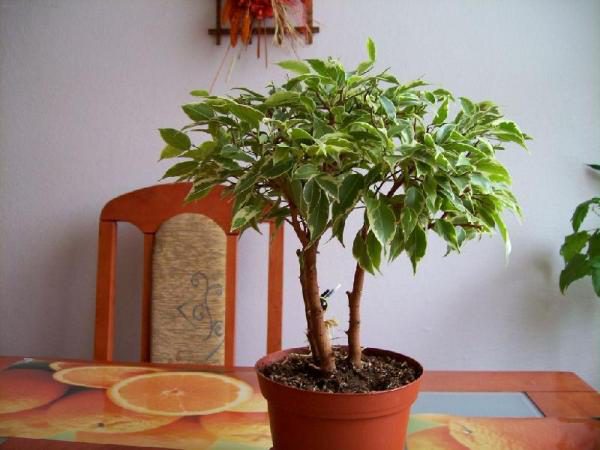

Ficus Benjamin sometimes secretes juice that provokes a serious illness - asthma
The Bible also speaks positively about this plant. The leaves of this tree became the first clothing for Adam and Eve.
The decision on whether to decorate your home with Ficus Benjamin is made individually. Think - the opinion of which people is closer to you, and already on this basis decide.
Diseases and pests: treatments
Major diseases:
- root rot is a fungal infection that affects the roots of a plant with excessive waterlogging. It is necessary to cut off all darkened and rotten roots, and then the crown of the plant;
- powdery mildew - white bloom on leaf blades, occurs when there is insufficient ventilation. The plant is treated with a fungicide solution;
- anthracnose - dark brown spots appear on the leaf blades, ulcers form over time. The affected leaves are removed, the tree is treated with a fungicide solution.
Ficus pests:
- scale insect - females suck out cell sap, this causes leaves to fall off. The plant needs to be treated with actellik solution 3 times (every 10 days);
- mealybug - the discharge of the pest is white, similar to pieces of cotton wool. The plant is treated 2 times with a confidor solution (the second time 2 weeks after the first treatment);
- spider mite - sucks out cell sap, leaves wither and fall off. Ficus is treated with an insecticide solution.
Ficus Benjamin is an elegant tree, very much in demand in landscaping interiors and the art of bonsai. Its densely packed leaves provide good shade. The plant is drought-resistant, therefore Benjamin's ficus is used for landscaping parks, squares and streets in regions with positive winter temperatures.
What to do if leaves turn yellow and fall?
The main reasons for this phenomenon:
- Excessive hydration.
- Low air temperature.
- Insufficient lighting.
- Pests.
- Iron or magnesium deficiency.
What to do if the ficus leaves the leaves:
- Plant transplant.
- Moving the flowerpot into a room with an optimal temperature for its growth (+ 20 ... + 29 ° in summer, above + 16 ° in winter) and sufficient lighting.
- Treatment of trees with pesticides.
- Top dressing with microfertilizers.
Popular varieties
"Baroque" ("Boucle")
Leaves are light green in color, curled, their length is about 6 cm. Due to the peculiar shape of the leaf apparatus, it looks good on a windowsill or near a window on a stand or table.


Baroque
Golden King
The leaves are green, their edging is golden.


Golden King
"Bushy Prince"
Leaves are bright green, oily in appearance.


Bushey Prince
"Viandi"
The plant forms a winding trunk.
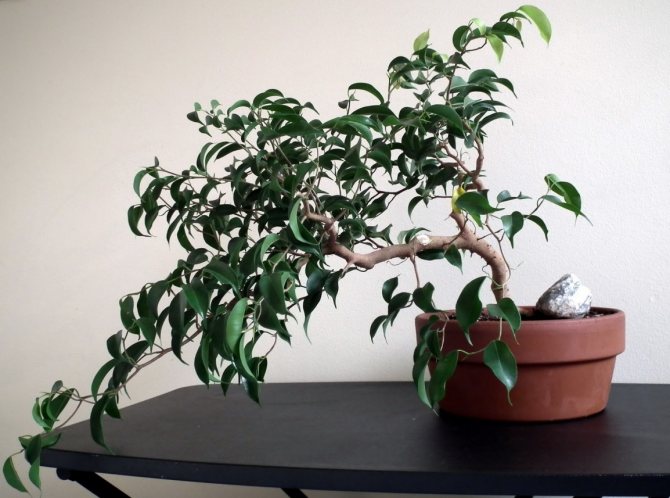

Wyandy
- "Golden Monique" - green leaves with dark blotches.
- "Gold Princesses" - light green leaves interspersed with a dark green hue.
- "Lakia" - green-white leaves.
- "Daniel" - leaf blades of a dark green hue. Looks spectacular in landscaping.
- "De Dumbbell" - green and white leaves.
- "Kurli" - the plant looks original because of the combination of dark green and cream shades in the color of the leaf blades.
"Midnight Lady"
The leaves are dark in color.
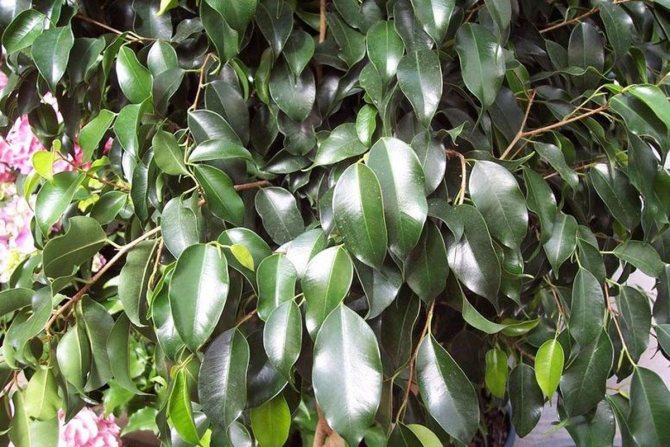

Midnight Lady
"Monique"
A beautiful plant with dark green leaf blades.
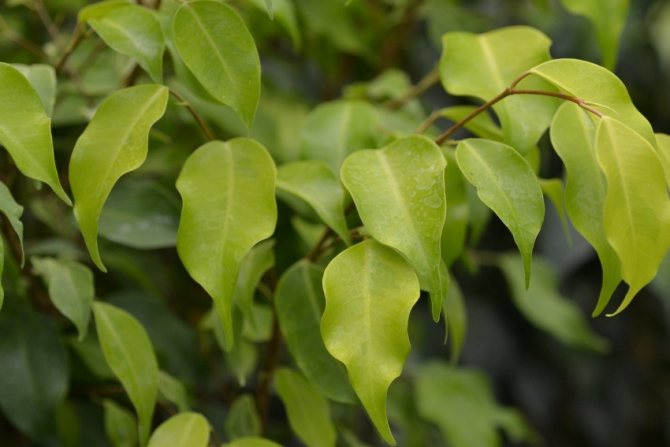

Monique
- "Esther" - the plant has golden leaves.
"Natasha"
Small leaf blades of a green hue, have a white edging, interspersed with a golden hue.
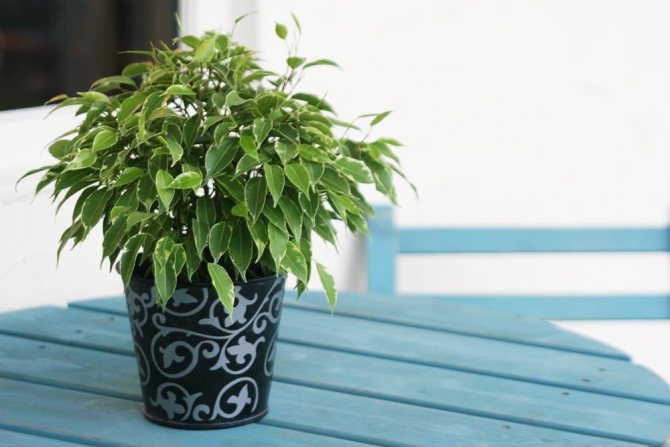

Natasha
- "Profit" - the color of the leaf blades is green with white.
- "Samantha" - leaves of a grayish-green hue, have a thin edging.
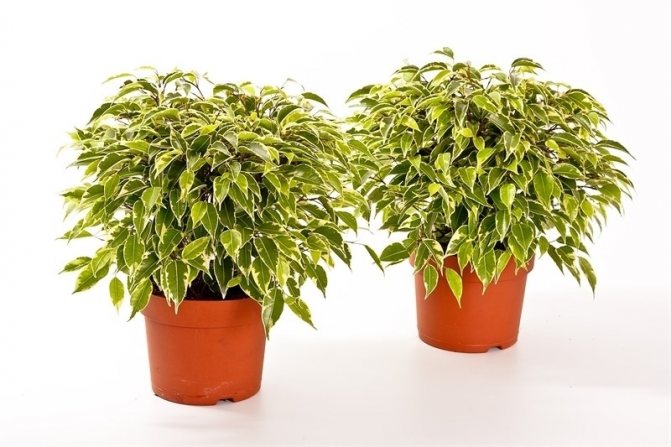

Kinky
This plant perfectly cleans the air in the room, absorbs harmful compounds. In many countries, ficus preparations are used to treat uterine tumors, furunculosis, osteochondrosis, radiculitis.
In Thailand, this plant is considered sacred. For its owner, it attracts happiness and good luck. In China, ficus is believed to create a cozy and pleasant atmosphere in the room. There are signs and superstitions that if a woman wants to get pregnant, she must definitely put a ficus tree in the bedroom.
Brief botanical reference
This plant, which has become a house tree, came to us from South Asia, the Philippines, and Australia.The height of the ficus Benjamin in natural conditions exceeds the mark of 8 meters, and indoors it is unlikely to outgrow 2 meters.


The trunk is gray-brown in color, and branches slightly bent downwards. The leaves are attached with small petioles (up to 2.5 cm). The sheet itself is oval in shape with a pointed oblong end. The length of the leaf plate is from 4 to 8 cm, the width is up to 4 cm. The dense glossy foliage creates a very decorative effect. The color of the leaves depends on the variety. There are dark green colors, many variegated foliage options, varieties with a light green color.
Varieties with white leaves
These varieties are often referred to as white figs. They have green blotches on the leaves, but the white color predominates.
These include:
- De Dumbbell;
- Twilight;
- Salt and pepper;
- Dominica;
- Irene;
- Nicole.
All of these varieties have a cream-white leaf color with a green center or dark spots.
The whitest ficus is De Dumbbell, which has snow-white, large and very beautiful leaves. Small-leaved variety Twilight has white leaves with green specks. Salt and pepper are more variegated, where white and green are combined in equal proportions. Dominica looks like De Dumbbell, but there are slightly more green spots on the leaves. Nicole and Irene are classified as white varieties, but they are more variegated in color.


Choosing a plant in the store
To get a large beautiful plant into the house, Benjamin's ficus is bought for adults in a garden supermarket. This should be done in spring or summer, when the plant has developed activity, it will more easily tolerate the move. Ficuses do not like changing the place of growth, they can shed all the leaves if the difference is significant, for example, in lighting, humidity.
It is better not to buy large specimens, as they are accustomed to the peculiarities of care in the store or greenhouse where they were grown. It will be difficult for the ficus to adapt to the new conditions.
The condition of the leaves is checked by shaking the plant. If the greens are crumbling, it is better to buy another copy from another store. Usually sellers themselves demonstrate this technique in order to convince buyers of a quality product. If, when shaken, shopkeepers start to resent, their plants are in poor condition or will become unusable when they move to a new location.
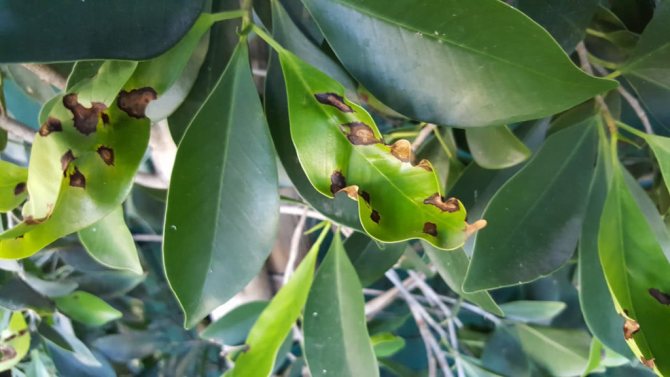

It is necessary to look at the bottom of the pot - if the roots are visible through the drainage holes, then they are constantly in the water and have already begun to rot. Such a condition cannot be allowed in a plant. The roots should not touch the water.
In large plant supermarkets, the leaves are rubbed with a special shine solution. This is a marketing ploy, but it prevents the ficus from breathing normally. It is worth asking the sellers about this technique; after the purchase, you should wash the crown with warm water under the shower.
The presence of a suspicious white fluffy coating, growths or cobwebs on the leaves indicates pest infestation. You cannot buy plants here - you can infect all domestic crops and then struggle with the problem for a long time.



